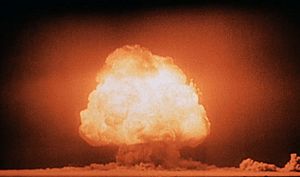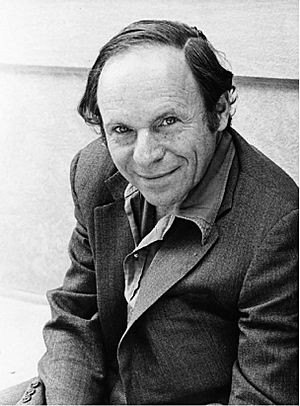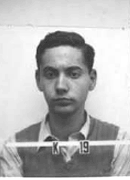Perseus (spy) facts for kids
Perseus was the code name for a possible Soviet spy. If he was real, he would have secretly entered the Los Alamos National Laboratory in the United States. This was during the time of the Manhattan Project, which was when the first atomic bombs were being developed. Some people believe Perseus helped the Soviet Union create their own nuclear weapons.
However, many experts today think that Perseus never actually existed. They believe he was a made-up story by Soviet intelligence.
Contents
Who was Perseus?
Perseus was described as a young American scientist. He was supposedly involved in the Spanish Civil War before the Manhattan Project.
In the early 1940s, Perseus was said to be in New York City visiting his sick parents. While there, he supposedly met Morris Cohen, an American who worked as a Soviet spy. Cohen was said to have recruited Perseus for the GRU, which was a Soviet intelligence agency. This meeting likely happened between September 1941 and July 1942.
Perseus reportedly told Cohen he was a physicist invited to work at Los Alamos. By 1942, Perseus was supposedly already working there. This was about 18 months before another atomic spy, Klaus Fuchs, joined the project in mid-1944.
Articles in Russia claimed Perseus helped the Soviet government because he believed in their ideas. He supposedly refused money for secret information. He was worried the United States would use the atomic bomb against the Soviet Union. He reportedly said:
"The Pentagon thinks it will take the Soviet Union many years to get atomic energy. Meanwhile, America will destroy socialism with the uranium bomb."
After Morris Cohen went to Europe, his wife, Lona Cohen, became a courier. She traveled to Albuquerque to collect information from Perseus. She then took this information to the Soviet consul in New York, Anatoli Yatskov. This secret information supposedly included important details about the Trinity Test, which happened in July 1945.
In the 1950s, Perseus was reportedly working under another spy named Rudolf Abel. Some sources even claim Perseus was still alive in 1991. Perseus was also known by other code names like "Mr. X," "Youngster," FOGEL, PERS, and "Mlad."
Was Perseus real?
Some people claimed Perseus was real, while others said he was a made-up story.
Claims he existed
Vladimir Chikov
In April 1991, a KGB officer named Vladimir Chikov wrote articles in a Russian magazine. He said that a Russian spy named Perseus worked on the Manhattan Project. Chikov shared details about how Perseus was recruited and what he achieved.
An article in The Washington Post talked about Chikov's claims. It said there were some confusing parts in Chikov's story. But it also suggested that the Soviet Union likely had such an agent. The article mentioned that new secret documents contained information that only a scientist with deep knowledge of the Manhattan Project could have known.
Anatoli Yatskov
In 1992, Anatoli Yatskov, a former Soviet consul in New York, gave an interview. He confirmed that Perseus existed and was an important person among the scientists on the Manhattan Project. Yatskov had worked as a Soviet intelligence agent, helping to coordinate atomic spies in the United States.
Yatskov explained how Perseus was recruited and how information was sent from New Mexico to New York. He confirmed that the Soviet Union received information from both Klaus Fuchs and Perseus.
Morris and Lona Cohen
Before he died in 1995, Soviet spy Morris Cohen said there was a second physicist spy on the Manhattan Project, besides Klaus Fuchs. The details Cohen shared matched what Colonel Vladimir Chikov had said earlier. This included the idea that an unknown scientist helped Soviet intelligence.
Morris Cohen also mentioned that Lona Cohen, his wife, helped transport stolen information. Lona Cohen herself confirmed in a 1992 interview that she had traveled between Albuquerque and New York to carry secret information. She remembered meeting with a scientist or physicist in New Mexico.
The Venona project was a secret United States program. It started during World War II and lasted until 1980. Its goal was to intercept and decode messages from Soviet government agencies.
The project managed to decrypt about 3,000 messages. While Perseus is not directly named in these files, there are mentions of a spy with the code name PERS or FOGEL. It seems the name PERS might have been mistakenly changed to Perseus at some point.
PERS was identified as one of four Soviet spies who secretly entered the Manhattan Project. Even though a 2012 publication by the NSA called PERS "important, but still unidentified," some people have used the Venona files to question if Perseus ever existed.
The 4th spy at Los Alamos
From the 1950s until 1995, three Soviet spies were known to have worked at Los Alamos: Klaus Fuchs, David Greenglass, and Theodore Hall. Fuchs confessed in 1950, leading to Greenglass. Hall's involvement was not known until 1995, when documents from the Venona project were released.
After the Soviet Union broke up, the stories from Chikov and Yatskov made people think there might have been a fourth spy at Los Alamos. This spy was thought to be Perseus (or PERS/FOGEL from the Venona files).
Claims he did not exist
Pavel Sudoplatov
In 1994, a Soviet agent named Pavel Sudoplatov wrote a book. He said he didn't remember the code name Perseus. He thought that Yatskov or his friends might have created Perseus to hide the real identities of Soviet informants. However, Sudoplatov also said that "Perseus" was sometimes used to refer to several different agents or unknown sources.
John Earl Haynes
John Earl Haynes, a historian of the Cold War, believes Perseus was made up. He based this on research by other authors. Haynes wrote that "Perseus" was likely a fake story created by Vladimir Chikov and the Russian intelligence service. He thinks it combined parts of Theodore Hall's story with false information.
However, Haynes agrees that there was likely a fourth Soviet spy at Los Alamos during the Manhattan Project. This spy would have been in addition to Klaus Fuchs, David Greenglass, and Theodore Hall.
Albright and Kunstel
Authors Joseph Albright and Marcia Kunstel wrote a book called "Bombshell." In a chapter titled "The Perseus Myth," they concluded that the spy never existed. They suggested that the KGB (a Soviet intelligence agency) might have created Perseus to make themselves look good, justify their work, and get more money from the government.
Gary Kern
In 2006, author Gary Kern shared his reasons for believing Perseus was an invention. Kern thought Perseus was a risky plan to spread false information. Its goals included:
- To show that the KGB was very important for the Soviet Union and later for Russia.
- To prove that the KGB was better at spying than American and British agencies, because they never caught the supposed Russian agent.
- To give more credit to Soviet intelligence agents for developing nuclear weapons, even if it meant making Soviet scientists seem less important.
- To use Soviet spies living in Russia for propaganda.
- To possibly make money by selling the story.
Possible identities
Philip Morrison
In 1999, Jeremy Stone, who led the Federation of American Scientists, published his memories. He wrote about conversations with someone he called "Scientist X," who he believed was Perseus. "Scientist X" was later identified as Philip Morrison, a physicist.
Morrison denied this accusation and gave strong reasons why it couldn't be him:
- Chikov said Perseus fought in the Spanish Civil War (1936-1939). But Morrison was studying at Berkeley during that time. Also, Morrison had Polio as a child, which affected his legs and made it hard for him to walk without a cane. This would make fighting in a war unlikely.
- Another source said Perseus visited his parents in New York City between 1941 and 1942. But Morrison's parents lived in Philadelphia, and his family lived in Pittsburgh.
Stone's reasons for suspecting Morrison were also questioned. Stone thought some of Perseus's ideas sounded like Morrison's. Also, Stone said Morrison seemed nervous when they talked about Perseus. But Morrison's nervousness could have been due to his polio.
Stone later accepted Morrison's denial, saying he couldn't argue with the facts. The controversy led some people to suggest Stone should apologize or even resign from his position.
Oscar Seborer
Historians John Earl Haynes and Harvey Klehr found FBI documents from the 2010s. These documents confirmed a suspected fourth spy named Oscar Seborer. Seborer was an American engineer who joined the US Army in 1942. He and his siblings supported the Communist Party.
Seborer was assigned to the Manhattan Project because of his engineering skills. However, Haynes and Klehr strongly state that Seborer should not be confused with Perseus. They believe Perseus was likely a made-up character based on Theodore Hall, and Seborer's life story does not match Perseus's description.
Theodore Hall
Historians John Earl Haynes and Harvey Klehr believe that while Perseus was not real, some parts of his story were based on the American Soviet spy and physicist Theodore Hall. Here are some similarities:
- Age: Hall was the youngest scientist on the Manhattan Project. Perseus was described as young, and one of his code names was "Youngster."
- Parents' home: Chikov said Perseus sought to be recruited in New York City after visiting his parents. Hall's parents lived in New York City, and he visited them around the same time.
- Code names: The code name "Mlad" was wrongly linked to Perseus but actually identified Hall. "Youngster" was used for both Hall and Perseus.
- Lifespan: Chikov claimed Perseus was alive in 1991. Hall lived until 1999, and his identity as a spy was not revealed until 1995.
Theodore Hall was a brilliant American physicist who graduated from Harvard at 18. He supported socialism because he was worried about the rise of fascism.
Haynes and Klehr noted that some details about Perseus did not match Hall. However, they concluded that Perseus was likely a made-up story. This story might have been created to protect Hall, who was still alive in the early 1990s. This could explain why some parts of Perseus's story matched Hall's, while others did not.
In popular culture
Perseus was first mentioned in a preview for the video game Call of Duty: Black Ops Cold War on August 19, 2020. He was later confirmed as the main bad guy in the game's story, which takes place in the 1980s with flashbacks to the Vietnam War.
Related pages
- Atomic Spies
- David Greenglass
- George Koval
- Manhattan Project
- Theodore Hall
- Rudolf Abel
- Venona project
- White Sands Missile Range
See also
 In Spanish: Perseo (espía) para niños
In Spanish: Perseo (espía) para niños




